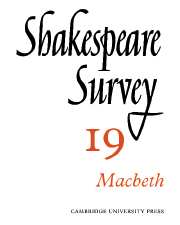Book contents
- Frontmatter
- ‘Macbeth’ in the Twentieth Century
- The Criminal as Tragic Hero: Dramatic Methods
- Antithesis in ‘Macbeth’
- Why was Duncan’s Blood Golden?
- Image and Symbol in ‘Macbeth’
- ‘Macbeth’ and The Furies
- Hell-Castle and its Door-Keeper
- ‘His Fiend-Like Queen’
- The Fiend-Like Queen: A Note on ‘Macbeth’ and Seneca’s ‘Medea
- Shakespeare at Street Level
- New Findings with Regard to the 1624 Protection List
- Shakespeare Productions in the United Kingdom: 1965
- The Royal Shakespeare Company 1965
- The Year's Contributions to Shakespearian Study: 1 Critical Studies
- 2 Shakespeare’s Life, Times and Stage
- 3 Textual Studies
- Index
- Plate Section
Shakespeare at Street Level
Published online by Cambridge University Press: 28 March 2007
- Frontmatter
- ‘Macbeth’ in the Twentieth Century
- The Criminal as Tragic Hero: Dramatic Methods
- Antithesis in ‘Macbeth’
- Why was Duncan’s Blood Golden?
- Image and Symbol in ‘Macbeth’
- ‘Macbeth’ and The Furies
- Hell-Castle and its Door-Keeper
- ‘His Fiend-Like Queen’
- The Fiend-Like Queen: A Note on ‘Macbeth’ and Seneca’s ‘Medea
- Shakespeare at Street Level
- New Findings with Regard to the 1624 Protection List
- Shakespeare Productions in the United Kingdom: 1965
- The Royal Shakespeare Company 1965
- The Year's Contributions to Shakespearian Study: 1 Critical Studies
- 2 Shakespeare’s Life, Times and Stage
- 3 Textual Studies
- Index
- Plate Section
Summary
The end of the eighteenth century and the beginning of the nineteenth saw the production of an enormous number of song-collections (often called ‘garlands)’ designed for the chapman’s market. Costing a penny for eight small pages (the first given over to a title-page adorned with a crudely cut and often irrelevant woodcut), a garland would contain the words—but not the music—of perhaps half-a-dozen songs, covering a wide variety of subjects, and appealing to a number of levels of taste: a sentimental love lyric in eighteenth-century clichés, a humorous poem describing an Irishman’s adventures in London, a poem in praise of the Battle of the Nile, a sailor’s lament at his absence from home, and so forth. These garlands thus throw an interesting light on the state of popular taste at the time.
Reading in a collection of these productions for a purpose remote from Shakespeare turned up the following three songs.2 So far as I know, they have not been quoted or commented on before. They differ from the broadsheet ballads based on Shakespeare's work which appeared until the end of the eighteenth century. The broadsheet ballads are virtually narrative verse, in spite of the occasional appearance of the words ‘To be sung to the tune of. . .’. But the poems in the garlands are more lyrical in shape, even though the garland rarely indicates the tune to be associated with them.
- Type
- Chapter
- Information
- Shakespeare Survey , pp. 95 - 100Publisher: Cambridge University PressPrint publication year: 1967
- 1
- Cited by

